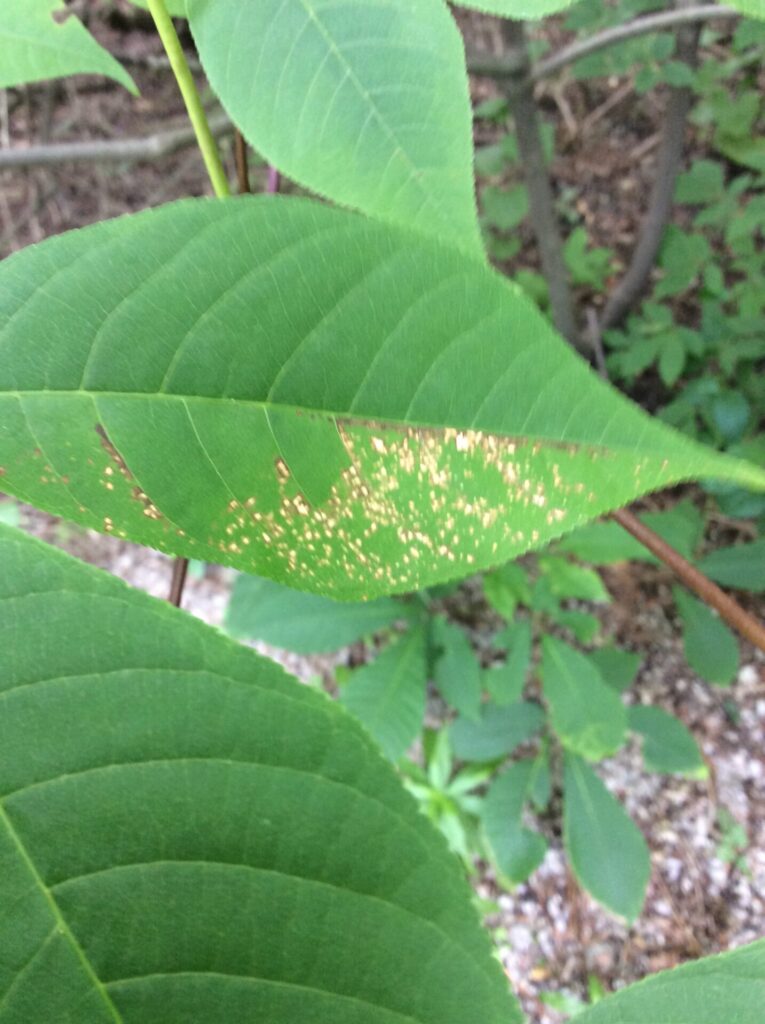
Can I stop these leaves from being eaten..first time in ten years..20 feet of them ,two trees/bushes on the south side of back garden..almost always damp ,clay soil,heavy.Shady .Reddish marks looks like spread of eggs on many of the leaves,getting worse.The spikes are there but no flowers so far.I have more photos to help .Should I send separately? One doesn’t do it I think.
Thank-you for contacting Toronto Master Gardeners with your question.
Bottlebrush buckeye (Aesculus parviflora) is a wonderful, statuesque shrub. It is usually fairly trouble-free. No wonder that you are concerned with your current insect infestation!
I, too, have a Bottlebrush buckeye specimen in my backyard. It has flower spikes, but no flowers yet, so you do not need to despair on that account. Your shrubs should bloom in the next week or so.
The kind of stippling damage showing on the leaves of your shrubs can be caused by different sorts of insects. It is difficult to make a definitive identification from the photo above. The leaf hopper causes stippling damage that looks similar to what you are experiencing. Flea beetle larvae cause a “window-feeding” damage which is also similar in appearance. In both cases, the damage, while unattractive, is not likely to affect the health of your shrubs. Only if the damaged areas become very extensive may there be insufficient photosynthetic tissue to supply the shrubs with the energy they require. You can try using an insecticidal soap, but it will only be effective if you are able to spray directly on the insects. On such large plants, it can be impractical to go this route. Do watch for signs of fungal growth. Many of the sucking insects excrete a sticky substance that leads to black fungal growths. These in turn can be magnets for disease. Twigs and branches with black powdery deposits should be cut away and disposed of in the garbage (not the compost) to reduce the chance of disease.
Having received your supplementary photos, I can see that the stippling is not the only injury your plants have suffered. The leaves of your bottlebrush buckeye have indeed been severely chewed as well. I suspect that it is a different culprit chewing the edges of the leaves, and in some cases skeletonizing them. Various type of caterpillars cause this kind of damage and this season, we are seeing a lot of them. Without seeing the actual caterpillar, it is hard to say which type it would be. They tend to feed at night and then retreat into the undergrowth where it is shady during the day. As you noted in your email, they may also have moved through this stage in their life cycle. Even if the larvae have moved on. keep an eye out for signs of egg masses. Hand picking is the best way to deal with caterpillars and the egg masses. The caterpillars and/or egg masses can be dropped into a bowl of soapy water and then disposed of. Insecticidal soaps are not really effective on them. As with the stippling damage, your shrubs will probably be able to withstand this attack as long as they have sufficient leaf mass to continue to photosynthesize adequately. Do ensure that your shrubs are well watered this year so that they do not have another stressor to deal with.
The resource below gives clues to identifying pests, based on the damage they cause. It also gives images of the insects which may assist you in identifying your pest.
Here is some general information on the Bottlebrush buckeye:
https://www.mortonarb.org/trees-plants/tree-plant-descriptions/bottlebrush-buckeye
Good luck with your shrub.

